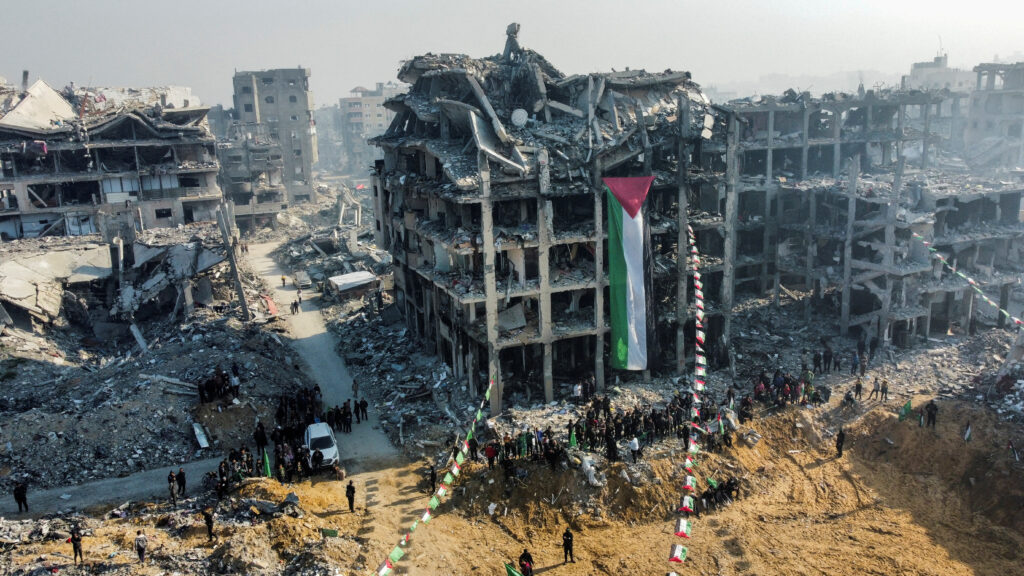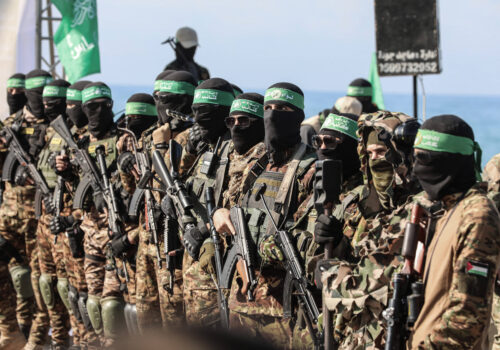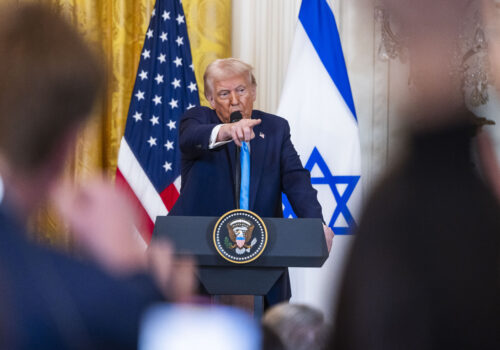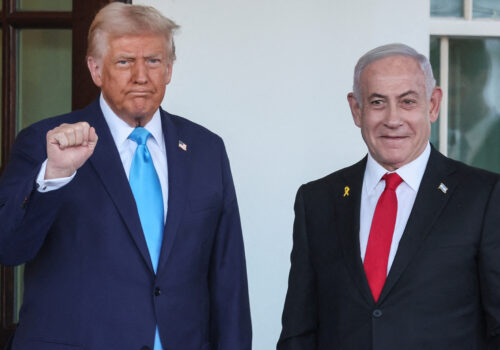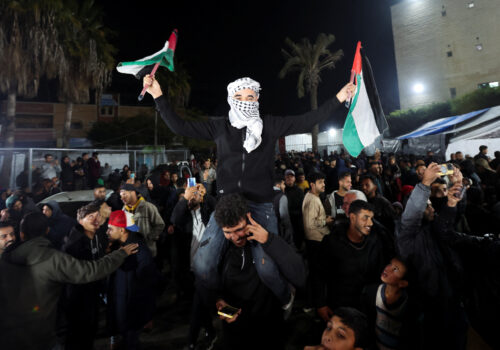US President Donald Trump’s proposed “takeover” of the Gaza Strip has generated headlines but not meaningful solutions for the intractable problems facing the coastal enclave.
While it is necessary to think about Gaza’s future, doing so through the prism of a US annexation of the territory is neither a feasible nor a helpful way to turn the Strip into a building block for Palestinian nationhood. There is a better way.
Out of the rubble
There are a number of short-term solutions to the immediate challenge of reconstructing the Strip. Gaza’s rubble should be recycled and used to create an artificial peninsula off its central coast. That peninsula could host an airfield and seaport that could serve as a non-Israeli and non-Egyptian lifeline as part of the Strip’s recovery and rebuilding. A floating power station could be docked offshore to provide the Strip with some supply of electricity. Concrete breakers could be placed in Gaza to deal with large chunks of rubble and clear space for people to place temporary mobile homes or caravans while they await reconstruction. Specialized US and Western teams could scour Gaza for unexploded munitions and defuse them before Hamas gets to these bombs and reuses them.
Temporary solutions for water purification and desalinization, vertical farming, and rubble removal represent opportunities for work and entrepreneurship that could make a massive difference in the short term. Throughout the war, most of Gaza’s population was concentrated in the south, meaning that they could stay there while the north is rebuilt.
Still, there are two fundamental problems that prevent Gaza’s true rejuvenation and renaissance as the pride and joy of the Palestinian people and a successful model for what an occupation-free West Bank could look like. The first is that Hamas, with its corrupt, violent, Islamist, and nihilistic ideology, remains in the territory, albeit significantly weakened and unlike what it was before the October 7, 2023, attack. The second is that the ethos of many Palestinians in Gaza connects them with the broader aspect of the Israel-Palestine conflict such that they are unable to separate their fate from what is happening in the West Bank or East Jerusalem. This means that many Palestinians don’t think of Gaza as the ultimate and only part of their nationhood, and so they are not solely focused on turning the Strip into the best possible space for Palestinians who live there.
These two strategic challenges are part of why the old postwar reconstruction systems and mechanisms will be insufficient to prevent future conflicts and disasters that get more Palestinians killed and waste more development resources. No quick fixes or magical solutions exist to address these two issues in a single fell swoop, necessitating strategic patience, phased implementations, creativity, and some difficult choices.
Break up the monopoly
The first and most crucial challenge in Gaza is to break Hamas’s monopoly on power, which allows it to hold the Palestinian people there hostage to nefarious and narrow visions that have been deeply destructive and harmful. This could be achieved through concerted efforts to deny Hamas financing, break off some of the group’s moderate members, and demand some form of exile for its senior military leaders still in Gaza.
This approach will require a long-term truce with Israel under international supervision. It will also depend on the provision of pathways for rehabilitating and integrating Hamas members under strict professional rules and codes of conduct. At the same time, Hamas in Gaza should be viewed and treated in isolation from Hamas in the West Bank. Breaking the organization into two distinct segments will mean that Hamas in the West Bank can never look to Hamas in Gaza for any sense of support or backing.
The second strategic challenge will require concerted and courageous messaging and a rewriting of the social contract that Gazans have with their rulers and the outside world. Assuming that it begins with an apolitical and technocratic group of professionals with some blessing from the Palestinian Authority, the government that emerges in Gaza will have to acknowledge to the people of Gaza that they have been failed, neglected, mistreated, and misled.
To atone for the horrendous killing, destruction, suffering, and squandering of potential and resources on display now in Gaza, all future leaders of the Strip should pledge to never again use sloganeering, violence, or unilateral action to risk the safety and prosperity of their people. As part of reshaping political awareness, a new media platform could be established to amplify alternative and dissenting voices and messages that challenge Hamas and destructive “pro-Palestine” perspectives. It could be called Radio Free Gaza.
As for the international community, including Arab and Western countries as well as nongovernmental organizations, there needs to be a formalized covenant that establishes the expectations for the support being provided to Palestinians in the territory. Gazans are entirely aid-dependent, and any self-sufficiency will take a significant amount of time to achieve. International support is meant to help the Palestinians build their nation and make Gaza the best possible place for its inhabitants. International support must not and should not be part of making Gaza a platform for instability, armed resistance, or political adventurism. This requires decoupling what happens in the Strip from occurrences in the West Bank or East Jerusalem.
After trust is rebuilt between Palestinians and Israelis, Gazans can expect to benefit from greater integration with Israel’s economy as well as with other parts of a future Palestinian state. Aid is not going to be provided in perpetuity in an ever-changing world beset by financial hardships, austerity, and a multitude of humanitarian and political crises. Palestinians in Gaza must leverage support to transform their reality instead of remaining captive to a repeating cycle of death, destruction, and reconstruction.
How Gaza rises
While these might seem like hefty goals, they are fundamental to a prosperous Gaza that can rise from the ashes and be reconstituted into something the Palestinian people would be truly proud of.
Trump isn’t wrong in wanting to fundamentally reshape the status quo, and many in Gaza would agree that a major shift is necessary. But imperial proclamations that do not actually solve problems are unhelpful distractions that force all the moderate Arab Sunni states into a difficult political position, which does not serve US interests and fails to bring stability to the region. Security, politics, and deradicalization can be addressed with creativity, a willingness to try new approaches, and an understanding that there is no simple US real-estate solution in Gaza.
Ahmed Fouad Alkhatib is a writer and analyst from Gaza City, and a resident senior fellow with the Scowcroft Middle East Security Initiative at the Atlantic Council’s Middle East programs.
Further reading
Wed, Feb 5, 2025
Experts react: Is the US really going to ‘take over’ the Gaza Strip?
New Atlanticist By
With his comments this week, the US president appears to be taking US policy toward Gaza in the direction of direct involvement—or is he?
Wed, Feb 5, 2025
Trump is serious about shaking up the Middle East, even if his Gaza plan isn’t
New Atlanticist By Jonathan Panikoff
It’s almost impossible to imagine Trump’s plan for Gaza coming to fruition. But it would be a mistake to think that he was anything but serious with the proposal he laid out Tuesday night.
Wed, Jan 15, 2025
Experts react: Everything you need to know about the Israel-Hamas cease-fire and hostage deal
New Atlanticist By
Does this deal really mark the end of the war? What’s next for Gaza’s reconstruction, for Israel’s security, and for wider regional efforts, such as Israeli-Saudi normalization? Atlantic Council experts share their answers to these and other pressing questions.
Image: A drone view shows a Palestinian flag on a damaged building in Jabalia, in the northern Gaza Strip, January 30, 2025. REUTERS/Mohammed Salem.
